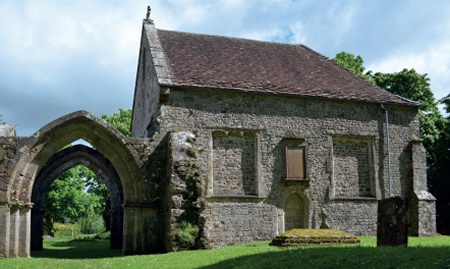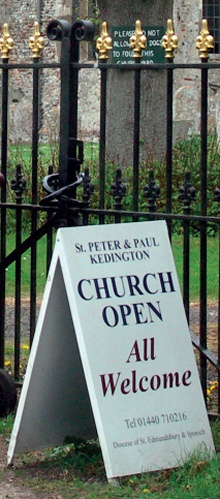The Future of England's Rural Parish Churches
Trevor Cooper
 |
|
| Yarpole church, Herefordshire: alongside its regular use for worship, a village trust uses the building as a shop and cafe. The trust is responsible for the upkeep of the building. The church is unusual in having a separate medieval bell tower, on the right in the image below. |
In September 2015 the Church of England published the Report of the Church Buildings Review Group, a major report on the future of its church buildings. Many of its findings were not new, but it is significant that it was the Church itself highlighting some of the problems.
Historic England, supported by others, then called for ‘a wider discussion’, suggesting perhaps a government commission or task force, and in his recent budget the chancellor announced a task force to carry out an English Churches and Cathedrals Sustainability Review. The task force will report to both the secretary of state for culture and the chancellor in April 2017.
After briefly discussing the report and its findings, this article will describe some of the options which the task force may want to consider. It will concentrate on rural parish churches, which have some of the most intractable problems.
It is striking that in rural areas some 96 per cent of people have no formal commitment to the upkeep of their parish church (that is, they are not on the church electoral roll), so I will focus on ways in which these people might share the load through voluntary and other bodies, at regional and local levels.
KEY FINDINGS OF THE REPORT
There are about 9,000 rural churches in England, of which about 8,200 are listed. A key finding of the church buildings report is that more than 2,000 of these rural churches have congregations of fewer than ten people. Although the report makes no mention of it, this is a sharp increase from the 2001 figure of 800 such parishes, caused by the continuing downwards drift in rural congregations.
 |
Statistics published elsewhere show that in rural dioceses some 40 per cent of worshippers are over the age of 70. This too is new, caused by a shortage of young people. Thus attendance is likely to go on declining for a while through natural causes, even if in future there is more effective recruitment of young people.
Based on figures in the report, rural church congregations spend about £55 million per year on their listed church buildings. On my estimate, it is likely that less than 20 per cent of this is provided by Heritage Lottery Fund grants (based on the number of rural listed churches compared to the overall number). The great bulk of the money comes from the efforts of the individual congregations.
POUNDS, PEOPLE AND PURPOSE
What are the consequences of having declining and ageing rural congregations? The obvious worry is how to fund the upkeep of the buildings. But the shortage of people has practical consequences too. Much of the routine care of rural church buildings and their graveyards is done by volunteers, and it is becoming harder to find people to do these jobs. In addition, the shortage of people makes it difficult to do new things – to fundraise for and carry out a large building project, or set up new community uses in the church.
Small congregations also have quite subtle implications. If the building is only used for one service each Sunday, or less often than that, with small numbers present, then in the eyes of those who do not attend it may be seen as a private club and the sense of public purpose of the building may be weakened. Furthermore, many church leaders are thinking of concentrating rural resources on fewer church buildings, so an increasing number of churches may no longer be required for regular worship. The risk is that such buildings almost entirely lose their sense of purpose. And a building without purpose is potentially at risk.
So the problem is not just financial. Money matters, but so does access to willing and capable people, and so does a sense of purpose for the building. These three are interdependent and interlinked: pounds, people and purpose. All are important.
THE GOVERNMENT’S ROLE
The ‘obvious’ solution is for the government to take full responsibility for caring for these churches, as happens in some other European countries. However, hoping that the government or, indeed, some other white knight will ride in and save the day is quite unrealistic.
 |
|
| St Leonard’s Church, Sutton Veny, Wiltshire: long-abandoned and partially ruined, St Leonard’s is in the care of The Churches Conservation Trust. It continues to hold an annual church service and its picturesque site draws visitors throughout the year. |
What might be possible is some long-term programme of financial assistance from the government, which could be grant aid for repairs or some other form of monetary support.
The case that has been made for such financial aid from government is that these historic buildings are being looked after by sparse populations, and that the buildings have value in supporting wider community work.
Perhaps we also need to emphasise to government that, unlike village halls, volunteers pay for these much-loved public buildings out of their own pockets and that it is only every few decades that help is needed, when a particularly large repair bill is faced. Also, unlike other visitor attractions, it is exceptionally difficult to charge visitors for entrance.
Guaranteed financial aid for listed church buildings would be hugely valuable, even though it would not help directly with people or purpose. But, however generous the government is in the future, this is only part of the answer. Mechanisms are needed which make it easier for the wider community to play a role. There are a number of models, some of which are discussed below.
SUPPORT
Parish council support In many rural communities there is a parish council or parish meeting and many towns have an equivalent town council. Yet despite an awareness of the importance of the church building to the community, councils rarely seem to contribute to its upkeep. There is indeed real doubt as to whether they have the right to do so.
There is scope here not only to sort out this confusion, but to include this opportunity in the guidance circulated to councils. Furthermore, the church building can become integrated into general community planning by ensuring that the congregation becomes involved in drawing up any parish plan, which also helps to clarify and publicise the purpose of the building. Of course, as well as money, parish councils can provide access to enthusiastic and committed people.
Support from Friends groups Friends groups are one of the great untold success stories of the past few decades. From a standing start, there are now about 1,000 stand-alone parish church friends groups registered with the Charity Commission, plus an unknown but possibly equivalent number of groups which don’t qualify as separate charities because they form part of a parochial church council. This is despite the absence of active central support, although in recent years guidance has become available on the websites of the Diocese of London and the National Churches Trust.
The income of these groups varies, but half of them raise between £1,800 and £8,000 per year, which is the same order of magnitude as typical annual maintenance and repair bills (as major repairs tend to occur only infrequently). Many groups organise activities which both raise money and bring people together, some of them in the church building, thus giving it a new purpose. So friends groups can provide the all-important pounds, people and purpose discussed above.
One-off support Another success story of recent years is the work of professional support officers. These officers help congregations to develop their churches for new purposes, engaging with local people and finding sources of finance. These posts typically last three years, although several have been extended beyond that, and are normally based in a diocese, half-funded by the diocese and half by Historic England. Unfortunately, government cuts to Historic England have put future funding for these posts at risk.
In an interesting variant, the diocese of Norwich recruits unpaid volunteer ‘ambassadors’ who have been through a major building project with their own church to help other congregations with their projects.
COMMUNITY USE
Almost every discussion of the future of church buildings mentions the opportunity to use them for community purposes. The core idea is that the congregation makes the building available for wider use. In addition to being an expression of neighbourliness and mission, this provides an income, and will also mean that there is a wider stakeholder group if major repairs are ever required. There are many examples where the future of a church building has been transformed through being regularly used for a variety of purposes.
But there are four reasons why this type of extended use cannot be a solution for every church. Firstly, small congregations are less likely to have the capacity to do this. Secondly, most villages already have village halls and may not need the extra space. Thirdly, in some rural areas the population is simply too sparse to generate the necessary demand for community use. Finally, it may not be possible to use the church building in this way, for heritage or other reasons.
COMMUNITY TRUST
Another model is for a community trust to take responsibility for the church building. The trust may use the buildings for the type of community activity described in the previous section. There may only be occasional services or the building may remain a normal parish church. The congregation may contribute towards the cost of the building (for example, by paying ‘rent’ to the community trust).
There are endless permutations of this approach but at its core lies the transfer of responsibility for the building to the community trust, with services continuing. So on paper at least it has the potential to provide the necessary human and financial resources, thus keeping the building in use. However, the legal complications are not for the faint hearted and I know of only a few examples where this is being attempted or has been achieved. In those cases, things are going well.
FESTIVALS ONLY
The Church of England has recently endorsed the idea of designating some of its church buildings as ‘festival churches’. There are many variants of the idea, but the core feature of a festival church (FC) is removal of the requirement for regular services.
 |
|
| Kedington, Suffolk: a church which is very clearly a public building, open to all |
One FC model is that the parish remains responsible for the church. Although not used for regular services, the building remains consecrated and may perhaps be used for Christian festivals, weddings and so on. A number of dioceses, including Lincoln and Ely, are considering using this model, and I suspect it may become common.
With this model, all costs and responsibilities remain with the parish, which will worship in one of its other church buildings. Although this saves a little money, it does nothing to involve more people or give the church building a new purpose and on its own it is hard to see this as anything other than a stop-gap solution.
USAGE ON DEMAND
An influential 2013 blogpost about FCs by Canon Anna Norman-Walker suggested that the diocese should be financially responsible for churches which were no longer required for regular worship. Each local community should pay for use of their church building, with the fee depending on what church services and other types of usage they want.
On the face of it, this has the potential to help bring in funds, involve new people and create new uses so long as sufficient interest can be generated in use of the building. However, if costs exceed income, then the diocese will effectively be ‘taxing’ active congregations in order to support unneeded buildings. I know of no examples of this model, but the diocese of Exeter – where some 90 churches have been identified as candidates for FC status – may be exploring it.
MORE OR LESS DORMANT
Another model is for a diocesan trust to take responsibility for the church (for example, a parish may contract with the trust to this end). The church is more or less dormant, but will be used for six or more services per year in order to preserve its right to apply for grants. The literature on this model does not mention community use and the implied purpose of the building is that it is to be enjoyed for its beauty and history and presence in the landscape.
This does nothing to engage more people, and it may therefore be appropriate for churches in sparsely populated areas. The model is sustainable only so long as the trust has the money and incentive to keep the building in good repair. Such a trust has been set up in the Diocese of Norwich, although it is not believed to be looking after any churches at present, partly at least because of unresolved legal issues.
SINGLE-BUILDING TRUST
About 20 churches a year are no longer needed for worship and are closed (or ‘made redundant’, although this phrase is now less commonly used). A few of these are transferred to the care of a local community trust. Some 40 churches are known to be in this situation, but this is certainly an underestimate. The most common pattern is for the church to be used occasionally for meetings, including fundraising events for the community trust; sometimes it becomes an active community hub.
The evidence shows that these community trusts are often effective at looking after the building and generating a good level of involvement from local people. Their greatest difficulty seems to lie not in raising funds, but in continuity of personnel. So both in principle and in practice it seems that these trusts are succeeding in finding the necessary resources for the buildings, maintaining them as public spaces.
A MATTER OF SURVIVAL
Rural church buildings need pounds, people and purpose if they are to survive as public buildings for the benefit of all. Shrinking congregations are putting them under pressure, but the government-led task force exploring the issue will find there are a number of models to keep the buildings in the public domain which are worthy of consideration and support.
~~~
Further Information
Church of England, Report of the Church Buildings Review Group, 2015, and Released for Mission: Growing the Rural Church, 2015 (both available at www.churchofengland.org)
T Cooper, ‘The Church of England and “Festival Churches”’ in Law & Religion UK, 14 February, 2016
T Cooper, How Do We Keep Our Parish Churches?, 2004 and For Public Benefit: Churches Cared for by Trusts, 2014 (both available at ecclsoc.org)
B Payne, Churches for Communities: Adapting Oxfordshire’s Churches for Wider Use, Oxfordshire Historic Churches Trust, Oxford, 2014
The e-newsletter of the Historic Religious Buildings Alliance will carry updates on the English Churches and Cathedrals Sustainability Review



